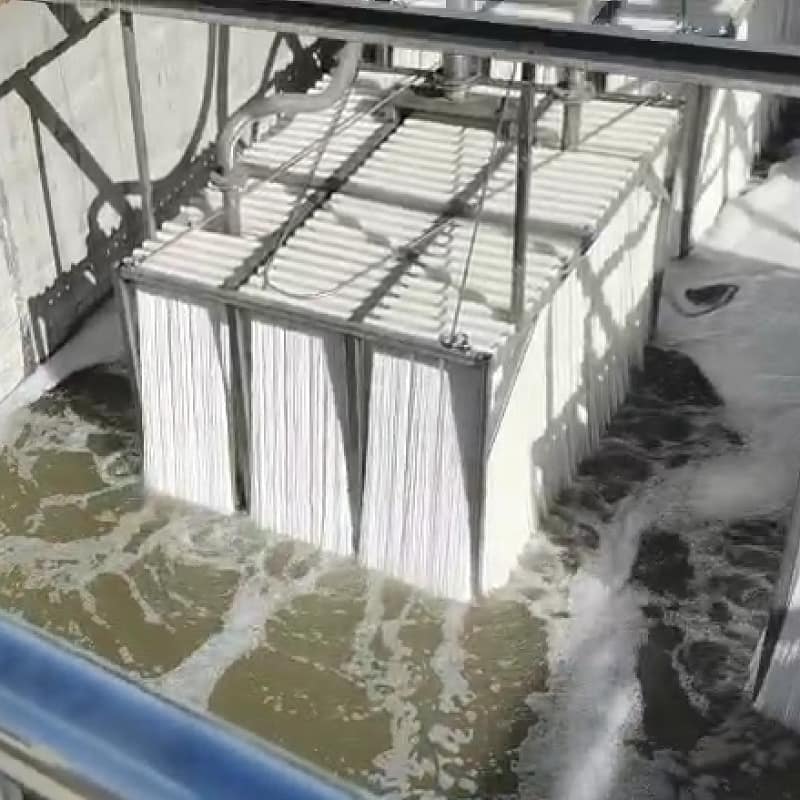MBR (Membrane Bioreactor) technology has become an essential solution for advanced wastewater treatment. By integrating membrane filtration with biological processes, MBR systems offer enhanced performance, greater sustainability, and superior treatment quality compared to traditional methods. These systems are widely utilized across industries that require high-quality effluent, such as municipal wastewater treatment, industrial facilities.
The operational efficiency of MBR systems largely depends on the influent water quality, system configuration, and the specific operating conditions. Regular monitoring of key performance metrics is essential to ensure that the system operates efficiently and maintains long-term reliability. Below, we outline key considerations for the operation, management, and maintenance of MBR systems.
- Transmembrane Pressure (TMP) Monitoring
Monitoring transmembrane pressure (TMP) is one of the most important tasks in the management of MBR systems. TMP is the pressure difference between the feedwater and the permeate (treated water) side of the membrane. A sudden rise in TMP typically signals membrane fouling, which can be caused by irregular aeration, sludge buildup, or deterioration in sludge quality. An increase in TMP is a warning sign that the system may not be operating efficiently, and it often necessitates intervention. To address TMP increases, review critical system parameters and perform actions such as chemical cleaning or backwashing to restore normal operation. - Aeration Conditions
Aeration plays a crucial role in the effective functioning of MBR systems by maintaining an aerobic environment necessary for biological treatment. The aeration rate must remain within the recommended range to ensure the appropriate mixing and oxygen transfer for microbial activity. Uneven aeration or deviations from the specified airflow range can lead to inefficient treatment and increased fouling. It is important to periodically check the aeration system for uniform airflow, clean any blocked aeration pipes, and adjust the aeration system as needed to maintain optimal performance. - Sludge Appearance and Odor
The appearance and odor of activated sludge provide valuable insights into the condition of the biological treatment process. In a healthy system, the sludge should appear brownish, with good flocculation, and have no unpleasant odor. If the sludge appears discolored or emits a foul odor, it may indicate an imbalance in the biological process or an issue with the water quality. To identify the cause, it is crucial to check parameters such as MLSS (Mixed Liquor Suspended Solids), sludge viscosity, DO (Dissolved Oxygen), pH, and BOD (Biochemical Oxygen Demand) load. These parameters can help diagnose whether the system requires adjustments in operational conditions. - MLSS (Mixed Liquor Suspended Solids)
Mixed Liquor Suspended Solids (MLSS) is a critical parameter for maintaining optimal biological activity within the MBR system. The recommended MLSS levels typically range from 5,000 to 10,000 mg/L. If the MLSS falls outside this range, it can affect the efficiency of biological treatment. Low MLSS levels can lead to poor microbial activity, while high MLSS can cause clogging and fouling of the membranes. To maintain the correct MLSS levels:- Low MLSS: Add seed sludge or reduce sludge discharge.
- High MLSS: Increase the sludge discharge to the thickening tank.
- Sludge Viscosity
The viscosity of the sludge in an MBR system affects the filtration efficiency and membrane fouling. If sludge viscosity exceeds 250 mPa*s, it can hinder membrane performance by increasing the resistance to filtration. Monitoring and controlling the sludge viscosity is essential for maintaining the system’s efficiency. Adjustments can be made by controlling sludge levels, optimizing aeration, or increasing the sludge discharge to manage the viscosity within the ideal range. - Dissolved Oxygen (DO)
Dissolved Oxygen (DO) is a key parameter in MBR systems as it supports the aerobic microorganisms responsible for treating the wastewater. Maintaining a minimum DO level of 1 mg/L is critical for ensuring optimal biological treatment. When DO levels fall below this threshold, the system may experience reduced treatment capacity. To prevent this, ensure that the aeration system is operating effectively, and consider increasing aeration or enhancing oxygen transfer efficiency to maintain the required DO levels. - PH Level
The pH level in an MBR system must be carefully controlled to ensure the optimal conditions for microbial growth and activity. A pH range of 6 to 8 is typically ideal for most biological processes in MBR systems. Deviations outside this range can lead to reduced microbial activity, which can impair the treatment efficiency. If the pH falls outside the acceptable range, you can adjust it by adding an acid or base to bring the system back to the desired operational range.. - Water Temperature
The temperature of the influent water can impact the biological and membrane filtration processes. For optimal operation, water temperature should be kept between 15°C and 40°C. If the water temperature exceeds or falls below this range, the biological treatment process may become less efficient. In cold conditions, microbial activity slows down, while in high temperatures, membrane fouling may accelerate. Implementing cooling or heating measures as necessary can help maintain the water temperature within the ideal range and ensure system efficiency. - Water Level Monitoring
Regular checks of water levels are essential for detecting potential issues. Ensure that the water level is within the normal range and address any abnormalities through the following checks:- Verify level indicators,
- Inspect water pumps,
- Monitor pressure differential across membranes.
- Membrane Integrity Check
Over time, membrane fibers may degrade or become damaged due to continuous exposure to aeration, contaminants, and other operational stresses. Membrane integrity should be regularly checked to ensure that the system continues to produce high-quality effluent. Small cracks in the membrane may not significantly affect performance, but larger cracks can lead to leaks and compromised filtration. Backflushing and pressure testing can help identify and address membrane damage before it causes significant operational issues.
Conclusion
To ensure optimal performance and longevity of MBR membrane systems, regular monitoring and maintenance of key operational parameters such as TMP, aeration, MLSS, and membrane integrity are essential. By maintaining these parameters within the recommended ranges, operators can enhance system efficiency, reduce operational costs, and prolong the lifespan of the system. Regular intervention, early detection of issues, and timely maintenance are key to maximizing the reliability and effectiveness of your MBR system.
For tailored guidance and expert support on optimizing your MBR membrane system, contact RANDL Environment today.

